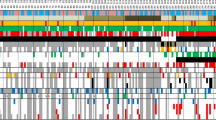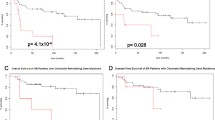Abstract
DNA derived from medulloblastoma biopsies was analyzed to determine if deletions of the 17p region, mutations of theTP53 gene, or amplification of the c-myc, N-myc, EGFR (epidermal growth factor receptor), orMDM2 (murine double-minute-2) genes was indicative of a poor prognosis. Loss of heterozygosity for 17p, observed in 8/28 (29%) paired samples, was associated with a shortened survival period (p=0.045 by the logrank test).TP53 mutations occurred in 2/46 (4.3%) tumor samples. c-myc Amplification was seen in 3/43 (6.9%) cases, while none of the tumors contained amplified N-myc, EGFR, orMDM2 genes. These results demonstrate that, while only rare medulloblastomas containTP53 gene mutations or amplification of the c-myc gene, loss of heterozygosity on chromosome 17p is indicative of a significantly worse prognosis among patients with these tumors. Further, these results provide a strong impetus for a prospective analysis of loss of heterozygosity in a cooperative group setting, which would include tumor staging, a selection of treatment modalities, and multivariate analyses.
Similar content being viewed by others
References
Cogen P, Dansehwar L, Metzgar AK, Edwards MS: Deletion mapping of the medulloblastoma locus on chromosome 17p. Genomics 8: 279–285, 1990
Cogen PH: Prognostic significance of molecular genetic markers in childhood brain tumors. Pediatr Neurosurg 17: 245–250, 1991–92
Bigner SH, Mark J, Friedman HS, Biegel JA, Bigner DD: Structural chromosomal abnormalities in human medulloblastoma. Cancer Genet Cytogenet 30: 91–101, 1988
Bigner SH, Mark J, Bigner DD: Cytogenetics of human brain tumors. Cancer Genet Cytogenet 47: 141–154, 1990
Biegel JA, Rorke LB, Packer RJ, Sutton LN, Schut L, Bonner L, Emanuel BS: Isochromosome 17q in primitive neuroectodermal tumors of the central nervous system. Genes Chromosom Cancer 1: 139–147, 1989
Thomas GA, Raffel C: Loss of heterozygosity on chromosome 6q, 16q and 17p in human central nervous system primitive neuroectodermal tumors. Cancer Res 51: 639–643, 1991
Biegel JA, Burk CD, Barr FG, Emanuel BS: Evidence for a 17p tumor related locus distinct fromp53 in pediatric primitive neuroectodermal tumors. Cancer Res 52: 3391–3395, 1992
Cogen PH, Daneshvar L, Metzgar AK, Geoffrey D, Edwards MSB, Sheffield VC: Involvement of multiple chromosome 17p loci in medulloblastoma tumorigenesis. Am J Hum Genet 50: 584–589, 1992
Ohgaki H, Eibl RH, Wiestler OD, Yasargil MG, Newcomb EW, Kleihues P:p53 mutations in nonastrocytic human brain tumors. Cancer Res 51: 6202–6205, 1991
Saylors RL, III, Sidransky D, Friedman HS, Bigner SH, Bigner DD, Vogelstein B, Brodeur GM: Infrequentp53 gene mutations in medulloblastomas. Cancer Res 51: 4721–4723, 1991
Bigner SH, Friedman HS, Vogelstein B, Oakes WJ, Bigner DD: Amplification of the c-myc gene in human medulloblastoma cell lines and xenografts. Cancer Res 50: 2347–2350, 1990
Batra SK, Metzgar RS, Hollingsworth MA: Molecular cloning and sequence analysis of human ribosomal protein S16. J Biol Chem 266: 6830–6833, 1991
Louis DN, von Deimling A, Seizinger BR: A (CA)n dinucleotide repeat assay for evaluating loss of allelic heterozygosity in small and archival human brain tumor specimens. Am J Pathol 141: 777–782, 1992
Buchman VL, Chumakov PM, Ninkina NN, Samarina OP, Georgiev GP: A variation in the structure of the protein-coding region of the humanTP53 gene. Gene 70: 245–252, 1988
Kaplan E, Meier P: Nonparametric estimation from in complete observations. J Am Stat Assoc 53: 457–481, 1958
Mantel N: Evaluation of survival data and two new rank order statistics arising in its consideration. Cancer Chemother Rep 50: 163–170, 1966
Nigro JM, Baker SJ, Preisinger AC, Jessup JM, Hostetter R, Cleary K, Bigner SH, Davidson N, Baylin S, Devilee P, Glover T, Collins FS, Weston A, Modali R, Harris CC, Vogelstein B: Mutations in thep53 gene occur in diverse human tumour types. Nature (Lond) 342: 705–708, 1989
Newcomb EW, Madania WJ, Pisharody S, Lang FF, Kowlow M, Miller DC: A correlative study ofp53 protein alteration andp53 gene mutation in glioblasloma multiforme. Brain Palhol 3: 229–235, 1993
Oliner JD, Kinzler KW, Meltzar PS, George DL, Vogelstein B: Amplification of a gene encoding ap53-associated protein in human sarcomas. Nature (Lond) 358: 80–83, 1992
Wasson JC, Saylors RL, III, Zeltzer P, Friedman HS, Bigner SH, Burger PC, Bigner DD, Look AT, Douglass EC, Brodeur GM: Oncogene amplification in pediatric brain tumors. Cancer Res 50: 2987–2990, 1990
Author information
Authors and Affiliations
Rights and permissions
About this article
Cite this article
Batra, S.K., McLendon, R.E., Koo, J.S. et al. Prognostic implications of chromosome 17p deletions in human medulloblastomas. J Neuro-Oncol 24, 39–45 (1995). https://doi.org/10.1007/BF01052657
Issue Date:
DOI: https://doi.org/10.1007/BF01052657




